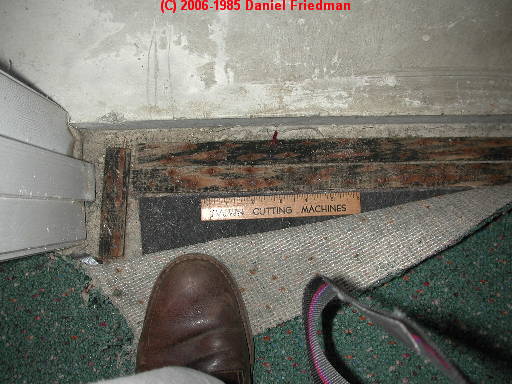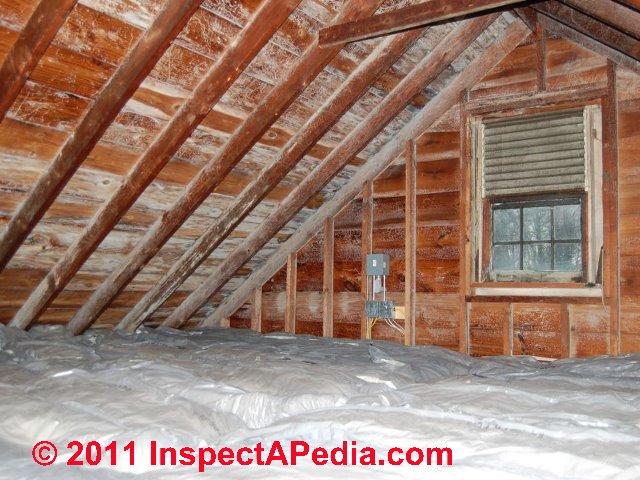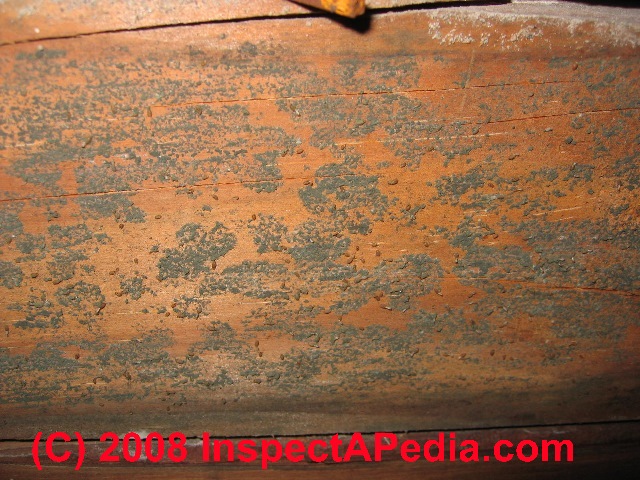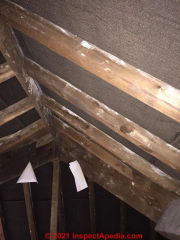 How to Look for Mold, Where to Test for Mold Contamination in Buildings
How to Look for Mold, Where to Test for Mold Contamination in Buildings
Where to sample for mold
Where to look for mold contamination
- POST a QUESTION or COMMENT about where mold contamination occurs in buildings, how to find building mold contamination reservoirs & when & how to test for mold.
How to find mold contamination in buildings:
This is a 'how to' photo and text primer on finding and testing for mold in buildings using simple clear adhesive tape on suspect or visibly moldy surfaces.
Choosing the Right Spot for Mold Testing Makes an Enormous Difference in Mold Test Results - here we start with a discussion of surface sampling of visible mold, settled dust, or any other dust, debris, or surface to be tested for particle identificvation.
InspectAPedia tolerates no conflicts of interest. We have no relationship with advertisers, products, or services discussed at this website.
- Daniel Friedman, Publisher/Editor/Author - See WHO ARE WE?
How to Choose the Right Mold Test Sample Location:
 Choosing the Right Spot for Mold Testing Makes an Enormous Difference in Mold Test Results - here we discuss Where to Collect Tape Samples of Surfaces
Choosing the Right Spot for Mold Testing Makes an Enormous Difference in Mold Test Results - here we discuss Where to Collect Tape Samples of Surfaces
This document describes how to find mold and test for mold in buildings, including how and where to collect mold samples using adhesive tape - an easy, inexpensive, low-tech but very effective mold testing method.
This procedure helps identify the presence of or locate the probable sources of mold reservoirs in buildings, and helps decide which of these need more invasive, exhaustive inspection and testing.
Separately at ACCURACY OF AIR TESTS for MOLD we describe similarly critical decisions about where & how air tests for dust, mold, other particles may be conducted.
People collect surface samples of visible mold or of settled dust to be screened for mold testing using clear adhesive tape to identify a visible mold on a surface, to screen settled dust for mold/allergens, or to test the cleanliness of a surface after mold cleanup.
Regardless of the reason, the adhesive tape mold test method can be very effective, in fact more reliable than spot checks of airborne particles (which vary widely minute by minute) and far more reliable than culture samples (which only grow a small percentage of all possible molds).
But everything depends on the selection of the sample location - "where you stick the tape."
This document explains where and where not to "stick the tape" when sampling for mold.
Random mold samples, tape sampling of arbitrary surfaces, or sampling the obvious "black mold" when investigating a building are practices which increase the risk of a serious error - missing what's important and finding what's not very important.
The result of these errors is the waste of time and money as well as the possible failure to find and address the real problem, leaving a health or cost risk in a Building to be handled again, and again, until it's addressed properly.
Mold is everywhere. You can't eliminate it. If you could we'd all be in trouble as nothing would ever decay and we'd all be so buried in junk and debris that nothing could grow on the earth. But we don't much like to see mold indoors and certainly not on our walls, ceilings, or furniture.
There we remove it or clean it off. This paper describes the detection of mold in buildings by visual inspection of mold-suspect surfaces. A thorough building investigation for problematic mold needs to address hidden mold reservoirs, for which our approach is to complete a detailed inspection and building (leak) history as well as to record occupant observations and complaints.
Knowing what molds are likely to be present indoors on building surfaces or in building materials, what they look like, and what they like to eat, in other words, knowing some mycology, can make a significant difference in what a building inspection for mold actually turns up.
See MOLD GROWTH on SURFACES for an index of what mold genera/species are frequently found on various building surfaces and materials.
Most common mold testing errors: the difference between what molds are found in buildings and what molds commonly grow on various building surfaces is that most mold tests and mold reports involve samples collected by people who are not expert at recognizing and sampling mold in buildings.
So easy-to-see molds are over-reported and hard-to-see molds are under-reported in many consumer-generated mold tests and samples. This reporting error also confounds attempts to correlate mold related illness and sick building complaints with specific genera or species of indoor mold.
Simple "mold screening methods" which omit the inspection, and "test only" sampling methods, such as air and culture methods can produce very unreliable results when used quantitatively - as we discuss at IAQ Methods and at other articles at this website.
See TEST KIT for DUST, MOLD, PARTICLES: INSTRUCTIONS for added about how to use clear adhesive tape to collect surface samples of mold or dust or other materials.
...
Reader Comments, Questions & Answers About The Article Above
Below you will find questions and answers previously posted on this page at its page bottom reader comment box.
Reader Q&A - also see RECOMMENDED ARTICLES & FAQs
On 2021-10-11 by Danielle - Does this white stuff in our attic look like mould?
Hello, we have an old Victorian house with white markings on the joists in our attic. There is no evidence of damp or mould anywhere else, no smells, no moisture and good ventilation up there. We think these marks are from when the roof tiles had lime render applied to their backs years ago. Does this look like white mould to you?
On 2021-10-11 by (mod) - no it looks like a coating
@Danielle,
I agree that the pattern of white deposits does not quite look like mold growth.
it would be helpful to know the country and city of location and age of the home and what kind of roofing materials were installed.From your later photo - now shown first above, this looks like a lime coating - often used as a fire retardant in older buildings.
On 2021-10-11 by Danielle - in Wales in the UK - white stuff on roof as seen in attic
@inspectapedia.com.moderator, we are in Wales in the Uk.
The house is from the 1880’s and we know that years ago the roof tiles were fixed using a lime render on the back (torching). Since then a felt membrane has been added but the joists are older than the membrane. Thanks for looking
On 2021-10-11 by (mod)
@Danielle,
By "roof tiles" do you know what was on the roof? I'm guessing wood shingles.
From at least the 1700s, perhaps earlier, people often coated interior wood surfaces with lime as an insectide, a fungicide, and in thicker coatings as an effort to improve fire resistance. In warmer climates, I'm not sure in Wales, lime coating also made the building interior a bit cooler.
But if the roof were limewashed for reasons other than insect or mold treatment, then iI'm surprised that the rafters were not coated too.
And I'm not familiar with use of the word "torching" with limewashing. (Torching is a hot process such as might be used on a tar and gravel roof - of lower slope than yours)
If what's there is lime it'll rub off easily on a finger.
See if you can get a sharper close-up photo.
The U.S. National Park Service has a nice article on this at
Frantom, Marcy, "Limewash: An Old Practice and a Good One" U.S. National Park Service, Cane River Creole National Historical Park,
- original source: www.nps.gov/articles/limewash-an-old-practice-and-a-good-one.htm
Welsh slate is some of the best in the world but would probably not get lime coated.On 2021-10-12 by Danielle
@inspectapedia.com.moderator, thank you for your response. In the uk torching is done with lime too and was used on the underside of our slate roof. It is still carried out in some heritage properties. I managed to find a photo of a property that still has the original lime in tact and you can see the markings on the roof structures look the same as ours. I will do as you say and take a much closer look. Thank you
On 2021-10-12 by (mod)
@Danielle,
Thank you for thiephoto examples. Do let us know what you find upon closer inspection.and continuing
can you tell us how thick is that lime applied? It looks like it's quite thick, perhaps 1-2 cm, but we can't say for sure from the photo.
If you have additional questions, please ask.
On 2020-10-31 by (mod)
Mold inside the HVAC system and on the blower pretty much assures that you're blowing mold spores, perhaps at a significant level, into building air.
Find and remove the mold in the system including the blower fan and ductwork and registers
Find and fix the cause of mold growth - a water leak somewhere.
I'm not sure what "insulation balls" are - nor the material, but that's not normal nor proper; perhaps your ductwork is insulation lined and has been damaged?
On 2020-10-31 by naomi
Hello,
I have had a strong mold smell all around my home, under it and within so bad that it was (in the summer) essentially uninhabitable.
Now there is just like a 'dead' smell, especially in the HVAC.
A HVAC tech just wanted to 'diagnose' my problem by saying he looked at the squirrel cage in a picture and could tell that it wasn't mold growing on it. To me from the info I find here, it looks like one type of mold growing on top of another. I can't access picture right now to add here.
I have severe lung disease and am on extensive treatment for having to live here with the mold.
The system also has had insulation blown into it through a hole near the HVAC unit. This HVAC tech ran the system with the door closed and when he did it blew insulation balls all over the house. One landed 12ft from register.
I told this to the people who sent him, all they want to do is send him back? Any information you have regarding him saying that there isn't mold from the picture would be appreciated. I'm already on high dose prednisone, a nebulizer and a 'last resort' breathing medication used when all others fail, due to breathing the mold and insulation dust. Now he wants me to trust his assessment?
On 2017-06-29 by Linda
I have invisible particles on my floors that seem to multiply on a daily basis. They also multiply on many of my belongings. They are very irritating and often times make me itch. Vacuuming and fogging and mopping help, but I can't seem to permanently ever get rid of this invisible menace. It feels like bugs but I can't see anything.
On 2016-03-05 by (mod)
DD
I cannot give a reliable, detailed mold remediation plan from a brief e-text, as a *proper* mold cleanup job includes
- finding all of the problem mold reservoirs, defining their location and extent - thus the extent of cleaning needed
(more than 30 sqft means you need a professional cleaning company)
- finding the leaks or moisture source that caused the mold growth and fixing those as well.
If drywall is moldy it needs to be removed as does wet or moldy building insulation that may then be exposed. Moldy framing, wall sheathing, paneling, other wood surfaces can usually be cleaned, and if appropriate, coated with a sealant.
On 2016-03-04 by D D S Jackson
I have mould behind the wood paneling in the front room. Could you tell me why it is there and can I get rid of it. The mould wasn't there before we put the wood up. It is an outside wall, the other side is the alley.
On 2015-10-20 by Anonymous
What to expect from insurance claim for professional environmental mold inspector ?
...
Continue reading at MOLD APPEARANCE - WHAT MOLD LOOKS LIKE or select a topic from the closely-related articles below, or see the complete ARTICLE INDEX.
Or see these
Recommended Articles
- LIGHT AIM FINDS MOLD & OTHER PARTICLES
- MOLD / ENVIRONMENTAL EXPERT, HIRE ?
- MOLD APPEARANCE - STUFF THAT IS NOT MOLD
Suggested citation for this web page
MOLD in BUILDINGS at InspectApedia.com - online encyclopedia of building & environmental inspection, testing, diagnosis, repair, & problem prevention advice.
Or see this
INDEX to RELATED ARTICLES: ARTICLE INDEX to MOLD CONTAMINATION & REMEDIATION
Or use the SEARCH BOX found below to Ask a Question or Search InspectApedia
Ask a Question or Search InspectApedia
Try the search box just below, or if you prefer, post a question or comment in the Comments box below and we will respond promptly.
Search the InspectApedia website
Note: appearance of your Comment below may be delayed: if your comment contains an image, photograph, web link, or text that looks to the software as if it might be a web link, your posting will appear after it has been approved by a moderator. Apologies for the delay.
Only one image can be added per comment but you can post as many comments, and therefore images, as you like.
You will not receive a notification when a response to your question has been posted.
Please bookmark this page to make it easy for you to check back for our response.
IF above you see "Comment Form is loading comments..." then COMMENT BOX - countable.ca / bawkbox.com IS NOT WORKING.
In any case you are welcome to send an email directly to us at InspectApedia.com at editor@inspectApedia.com
We'll reply to you directly. Please help us help you by noting, in your email, the URL of the InspectApedia page where you wanted to comment.
Citations & References
In addition to any citations in the article above, a full list is available on request.
- Adkins and Adkins Dictionary of Roman Religion discusses Robigus, the Roman god of crop protection and the legendary progenitor of wheat rust fungus.
- Kansas State University, department of plant pathology, extension plant pathology web page on wheat rust fungus: see http://www.oznet.ksu.edu/path-ext/factSheets/Wheat/Wheat%20Leaf%20Rust.asp
- A BRIEF GUIDE to MOLD, MOISTURE, and YOUR HOME, [PDF] U.S. Environmental Protection Agency US EPA - includes basic advice for building owners, occupants, and mold cleanup operations. See http://www.epa.gov/mold/moldguide.htm
- US EPA - MOLD REMEDIATION in SCHOOLS & COMMERCIAL BUILDINGS - - US EPA
- US EPA - UNA BREVA GUIA a MOHO / HONGO - en Espanol
- "IgG Food Allergy Testing by ELISA/EIA, What do they really tell us?" Sheryl B. Miller, MT (ASCP), PhD, Clinical Laboratory Director, Bastyr University Natural Health Clinic - ELISA testing accuracy: Here is an example of Miller's critique of ELISA - www.betterhealthusa.com/public/282.cfm - Townsend Letter for Doctors and Patients
The critique included in that article raises compelling questions about IgG testing assays, which prompts our interest in actually screening for the presence of high levels of particles that could carry allergens - dog dander or cat dander in the case at hand.
- www.tldp.com/issue/174/IgG%20Food%20Allergy.html - contains similar criticism in another venue but interestingly by the same author, Sheryl Miller. Sheryl Miller, MT (ASCP), PhD, is an Immunologist and Associate Professor of Basic and Medical Sciences at Bastyr University in Bothell, Washington. She is also the Laboratory Director of the Bastyr Natural Health Clinic Laboratory. - Allergens: Testing for the level of exposure to animal allergens is discussed at http://www.animalhealthchannel.com/animalallergy/diagnosis.shtml (lab animal exposure study is interesting because it involves a higher exposure level in some cases
- Allergens: WebMD discusses allergy tests for humans at webmd.com/allergies/allergy-tests
- Rodent control issues, including dander, fecal, and urine contamination of Buildings and Building insulation are discussed at our
- Atlas of Clinical Fungi, 2nd Ed., GS deHoog, J Guarro, J Gene, & MJ Figueras, Centraalbureau voor Schimmelcultures, Universitat Rovira I Virgili, 2000, ISBN 90-70351-43-9
- "Disease Prevention Program for Certain Vegetable Crops," David B. Langston, Jr., Extension Plant Pathologist - Vegetables, University of Georgia (PDF document) original source: www.reeis.usda.gov/web/crisprojectpages/209797.html
- Disease Prevention in Home Vegetable Gardens [PDF], Patricia Donald,Department of Plant Microbiology and Pathology,
Lewis Jett
Department of Horticulture, University of Missouri Extension - extension.missouri.edu/publications/DisplayPub.aspx?P=G6202 - "Management of Powdery Mildew, Leveillula taurica, in Greenhouse Peppers," Ministry of Agriculture and Lands, British Columbia - Original source: www.agf.gov.bc.ca/cropprot/peppermildew.htm
- Fifth Kingdom, Bryce Kendrick, ISBN13: 9781585100224, - we recommend the CD-ROM version of this book. This 3rd/edition is a compact but comprehensive encyclopedia of all things mycological. Every aspect of the fungi, from aflatoxin to zppspores, with an accessible blend of verve and wit. The 24 chapters are filled with up-to-date information of classification, yeast, lichens, spore dispersal, allergies, ecology, genetics, plant pathology, predatory fungi, biological control, mutualistic symbioses with animals and plants, fungi as food, food spoilage and mycotoxins.
- Fungi, Identifying Filamentous, A Clinical Laboratory Handbook, Guy St-Germain, Richard Summerbell, Star Publishing, 1996, ISBN 0-89863-177-7 (English)
- US EPA: Mold Remediation in Schools and Commercial Building [Copy on file at /sickhouse/EPA_Mold_Remediation_in_Schools.pdf ] - US EPA
- In addition to citations & references found in this article, see the research citations given at the end of the related articles found at our suggested
CONTINUE READING or RECOMMENDED ARTICLES.
- Carson, Dunlop & Associates Ltd., 120 Carlton Street Suite 407, Toronto ON M5A 4K2. Tel: (416) 964-9415 1-800-268-7070 Email: info@carsondunlop.com. Alan Carson is a past president of ASHI, the American Society of Home Inspectors.
Thanks to Alan Carson and Bob Dunlop, for permission for InspectAPedia to use text excerpts from The HOME REFERENCE BOOK - the Encyclopedia of Homes and to use illustrations from The ILLUSTRATED HOME .
Carson Dunlop Associates provides extensive home inspection education and report writing material. In gratitude we provide links to tsome Carson Dunlop Associates products and services.




